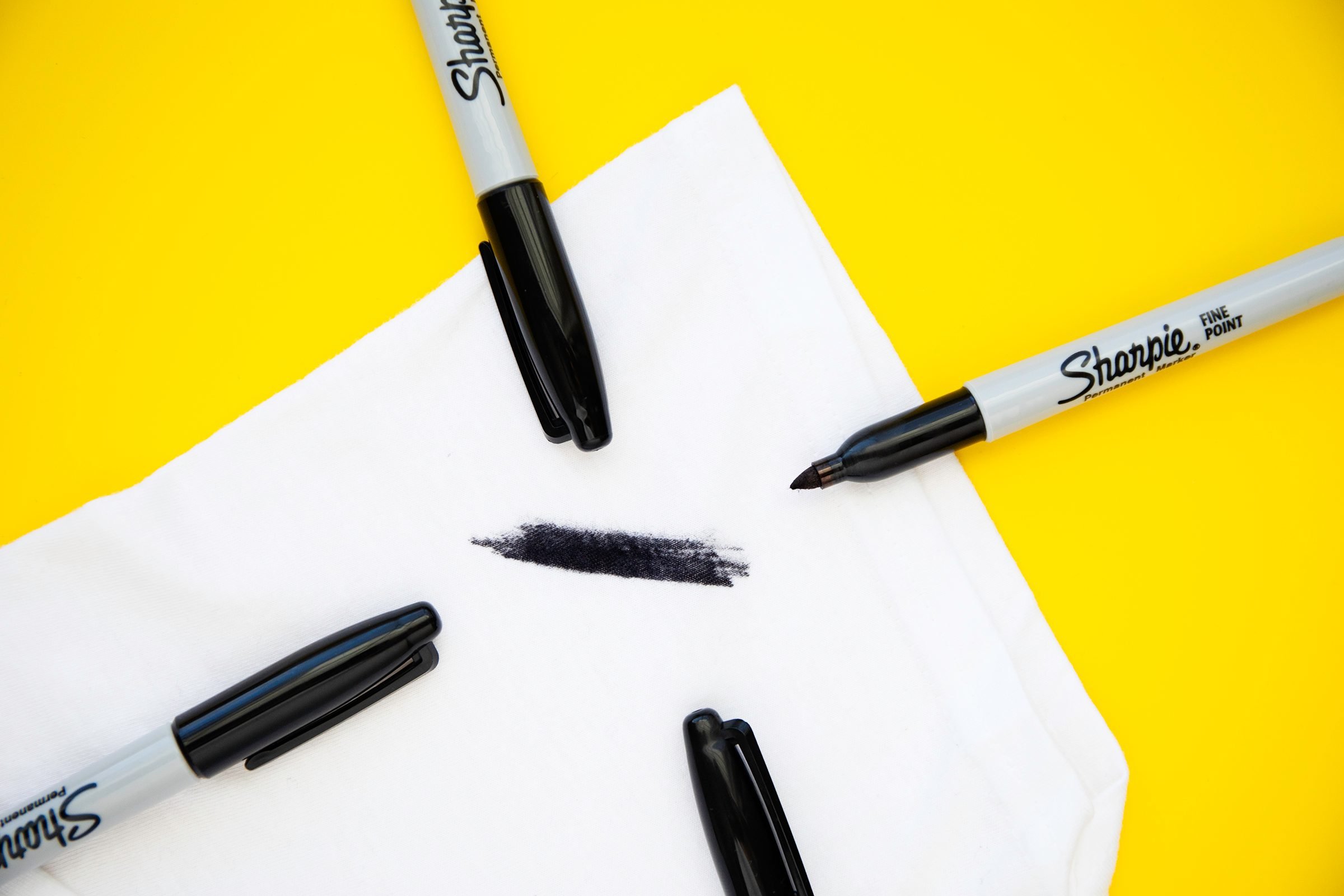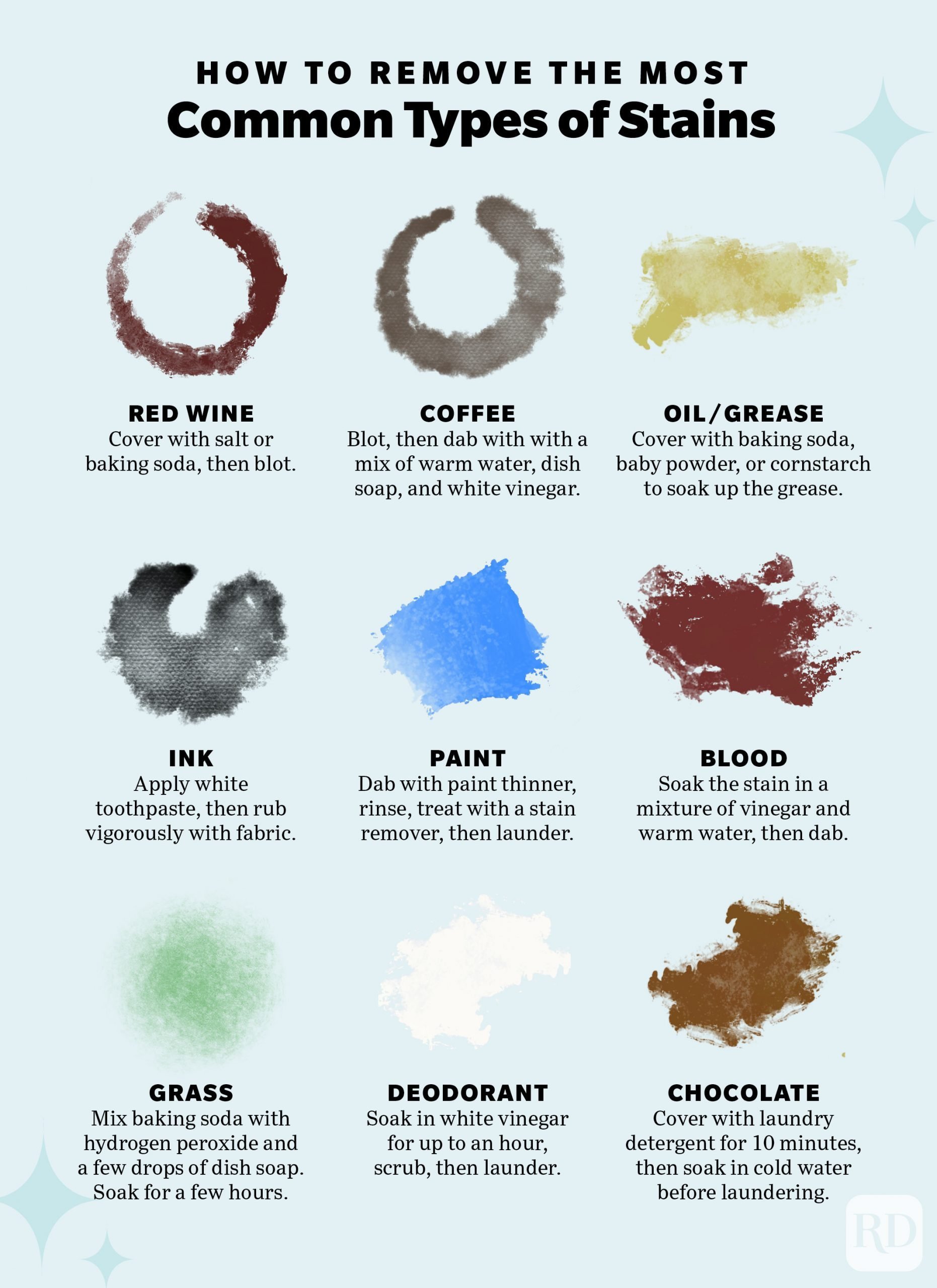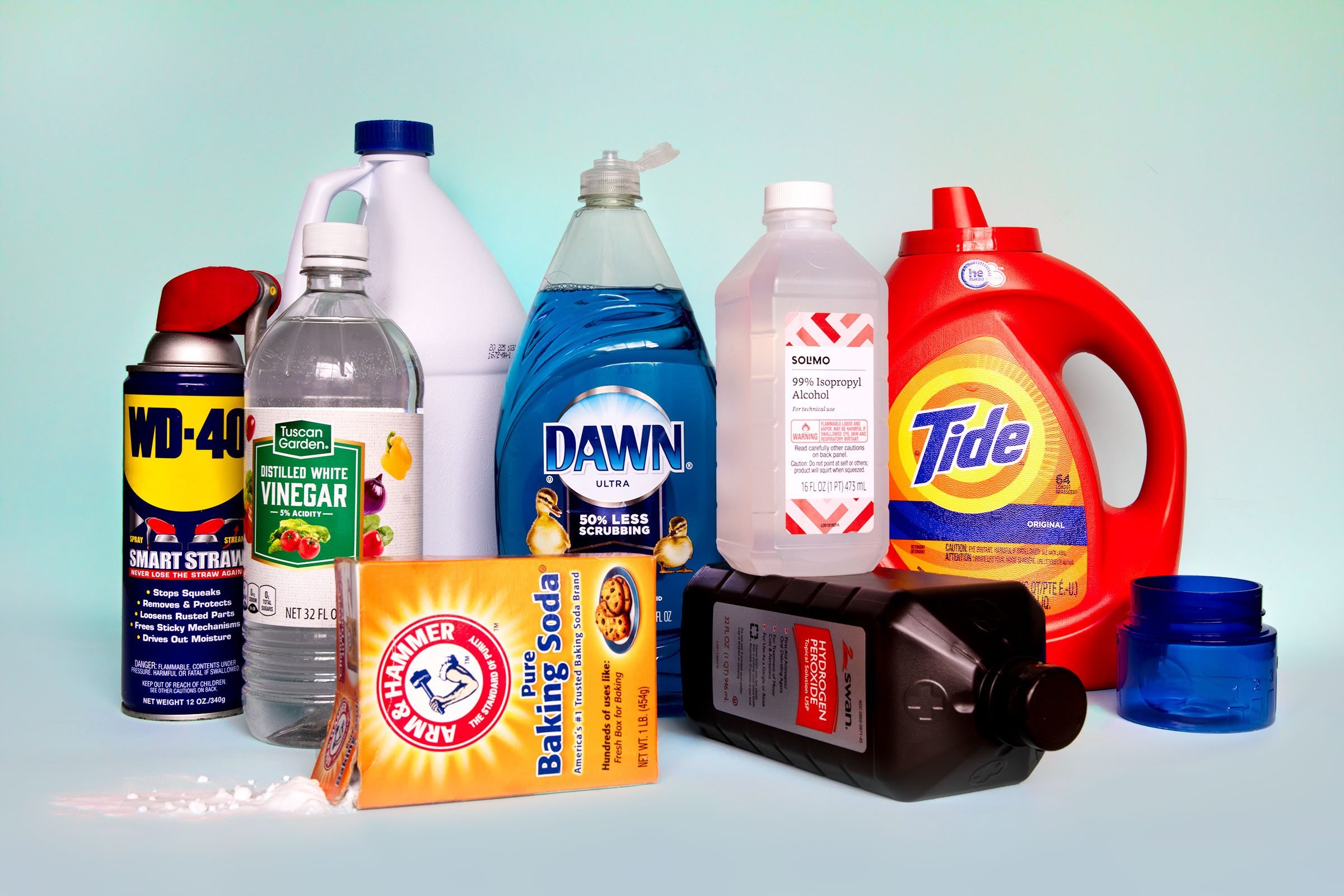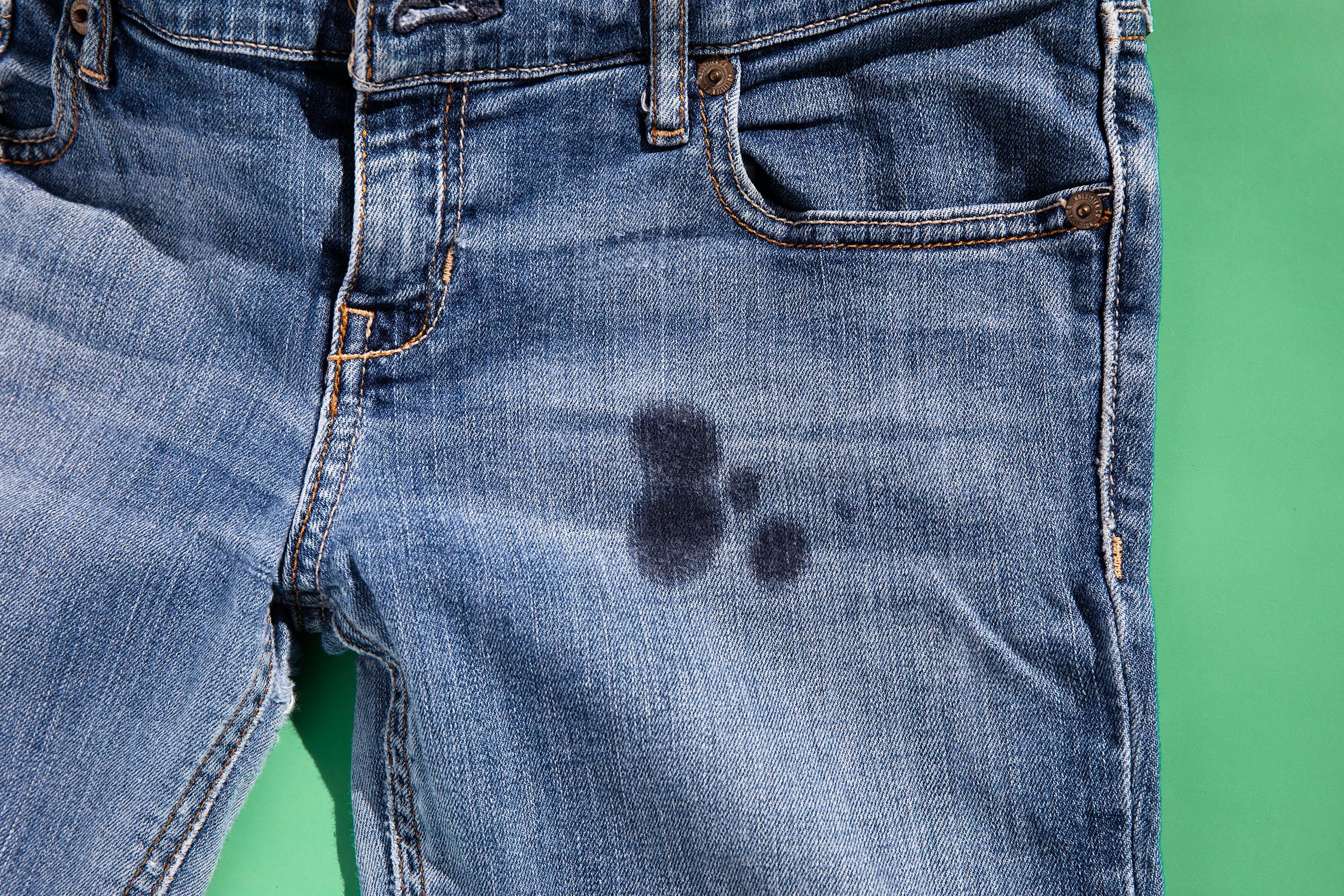how to remove period stains
Every editorial product is independently selected, though we may be compensated or receive an affiliate commission if you buy something through our links. Ratings and prices are accurate and items are in stock as of time of publication.
Stains happen but they don't have to be permanent. Here are expert tips for removing the most common stains from clothes, carpets, and countertops.
Life is messy. If you're going to enjoy a glass of wine or a cup of coffee, you're inevitably going to spill some. Art projects are likely to get paint and ink in unintentional places, cooking can splash grease and oil, and adventures sometimes result in blood stains.
Stains happen to everyone, but we've got expert advice to help you get rid of them so you can eat, drink, paint, and live without worrying. You definitely want to keep those memories of your fun times in your heart—but not on your clothes or carpet. We can also help you learn how to get nail polish out of just about everything, how to remove sticker residue, and how to remove super glue.
ⓘ
Most common stains
Coffee stains
If you drink coffee every day, spills are bound to happen. But don't worry—those brown spots can come out. Blot up as much of the coffee as you can right away. Then mix together warm water, dish soap, and white vinegar, and use a clean white cloth to blot the stain with the solution. If you can't get to it right away, use a little warm water to loosen the dried coffee first. Here's how to get coffee stains out of carpet.
Wine stains
Some cleaning experts swear by Wine Away, a stain-removing product made for red spills including wine, fruit punch, tomato soup, and marinara. If you don't have it on hand, make your own stain remover by mixing equal parts hydrogen peroxide and a blue dish soap like Dawn. Learn how to get red wine out of carpet.
Oil and grease stains
Anyone who's dripped salad dressing on their favorite shirt knows how tough it can be to get oily spots out of clothes. The key to removing them is to first soak up as much of the grease as you can with a powder, such as baking soda, baby powder, or cornstarch.
Blood stains
Skinned knees, bloody noses, shaving nicks. You can get unexpected blood stains out of your favorite fabrics, but the key is doing it as soon as possible—dried blood can leave a permanent mark. In fact, blood is probably the hardest stain to remove from carpet, according to Samantha Hodges, director of digital marketing at Rugs.com. Luckily, you probably already own one of the best blood removers: white vinegar. Soak the stain for five to ten minutes in a mixture of one cup vinegar and two cups warm water, then dab the blood away. Find out more about how to remove blood stains from clothes.
Paint stains
Act fast! Once water-based paint is dry, it won't come off. If you get to it while it's still wet, simply rinse the paint out under warm water, then wash as usual. For oil-based varnish and paints, dab the spot with paint thinner or turpentine, then rinse, treat with a stain remover, and launder. Here's how to get paint out of clothes.
Ink stains
Whether your child "accidentally" wrote on your sleeve or a pen leaked in a pocket, we've got a few effective options for getting it out, from a homemade paste to good old rubbing alcohol. Start with this: Apply plain white toothpaste to the pen mark, then rub vigorously with fabric to lift the stain away.
 Alaina DiGiacomo/rd.com
Alaina DiGiacomo/rd.com
Stain removal tips and guidelines
No matter what kind of stain you're trying to remove, experts recommend the following:
- Act quickly. "Without a doubt, the easiest way to remove stains is to address them as soon as possible," says Angie Tran, co-founder of Kind Laundry. "Even the most miraculous stain removers will have a harder time removing a stain that has been left to dry out before being treated."
- Blot—don't rub!—with a paper towel or clean white cloth. "Blotting is key to removing stains," according to Hodges. "You never want to rub because the stain could spread into the fibers of the fabric and become more difficult to remove."
- Use cold water. "Always start with cold water because it's least likely to set a stain," advises Marilee Nelson, co-founder of Branch Basics. "Hot water can set protein stains like milk, egg, or blood, and should never be used on stains of unknown origin."
- Don't let stains dry. "Keep the stain away from direct heat, including lamps," says Alicia Sokolowski, president and co-CEO of AspenClean. "Never put stained garments into the dryer. The heat will set the stain."
- Check labels or test before treating. All the experts stress the importance of following instructions on garment labels since certain fabrics may require dry cleaning only. If you're trying to remove a carpet stain, do a test on a small, inconspicuous area first.
- Persist! You may have to repeat treatments a few times or even try different ones but don't give up. "Even years-old stains have been annihilated with persistence," says Nelson.
Stain removal chart
 Emma Kumer/rd.com
Emma Kumer/rd.com
Print This Now
Stain removal methods and solvents
Removing stains takes a bit of elbow grease, plus one or more of the following best stain removers:
Water
Your first go-to should always be water as it dilutes stains and helps them fade. "Water is often overlooked as a great cleaner and spot remover," says Sokolowski. Water dilutes stains and helps them fade. It may actually be all you need. "You should always start with plain, cold water and add other cleaners only if necessary." The only caveat: don't use water on fabrics that are dry clean only.
Vinegar
According to Sokolowski, vinegar is a powerful cleaner and stain remover because of its acidity and low pH. "A paste of vinegar and baking soda can remove even the toughest stains," she says. There's a misconception that vinegar will remove color from clothes but in fact, it's gentle enough to use on most fabrics, vinegar can actually restore and brighten color in fabric and can also prevent fading. It should be used with caution, however, on natural materials like wood.
Hydrogen peroxide
Because it's a natural bleach alternative and can sometimes cause discoloration, hydrogen peroxide works best on white fabrics. To remove grease and oil, Tran recommends gently mixing three parts hydrogen peroxide with one part dishwashing liquid. Apply it to the stain and let it sit for 20 minutes to an hour. Once the stain has been lifted, rinse it and throw the garment into your regular wash.
Detergent
Detergent can be used before you do your laundry in addition to during it. Simply apply a little bit of liquid detergent to the stain and use your fingers to rub it in. Then wash the garment as usual. This is a safe method for any item you can machine wash.
Rubbing alcohol
Rubbing alcohol can help clean and disinfect hard surfaces, plus it dries quickly and kills bacteria. Because it's a solvent, it's good for dissolving dirt and oil. While not suitable for use on rayon, silk, wool, acetate, or acrylic, it works well at lifting stains like wine and pen ink from other fabrics. Tran suggests gently sponging rubbing alcohol into the stain, then rinsing thoroughly, and washing as you normally would.
Ammonia
A tablespoon of ammonia mixed with half a cup of water can work as a great pre-wash treatment for stains, according to Tran. Simply apply and let soak for 10 minutes before washing. Ammonia can be irritating to the skin, eyes, and respiratory tract, though, so use it cautiously. And never mix ammonia with chlorine bleach. The combination produces a highly toxic gas that can cause headaches, seizures, and even death.
 Alaina DiGiacomo/rd.com
Alaina DiGiacomo/rd.com
Dish soap
Because it's designed to get out tough food stains on plates and bowls, dish soap—some brands of which have been safely and effectively used on marine animals after major oil spills—can be a good choice for garments stained by greasy foods. You can apply it to the stain or let the garment soak in it for a few hours. Then rinse out the soap and wash as usual.
Bleach
Across the board, experts try to avoid bleach because it can cause discoloration and damage—not just to fabrics but to the human body. "In the case of a permanent ink stain, bleach is likely the only option," says Tran. "But even then, it may not fully lift, and should only be tried on white clothing."
Baking soda
Baking soda is perfect for stains on clothing, rugs, or couch upholstery. It helps to absorb spills, especially in a paste made from one cup of baking soda and half a cup of water. As the paste dries, it removes the stains and can then be vacuumed or laundered.
Best stain removers
While homemade carpet cleaners are effective at cleaning stains, sometimes you may want something a bit more powerful. That's when professional stain removers come into play. Here are ones the experts rely on:
- OxiClean uses the power of oxygen to remove even the toughest stains and is a favorite of the pros. With more than 18,000 five-star reviews on Amazon, it's also a favorite of everyday users.
- Uni-Cleaner Rug & Fabric Cleaner is an all-purpose cleaner meant for almost every type of rug and stain. It even has a protectant mixed in to keep them looking fresh and safe from future stains.
- Branch Basics All-Purpose Cleaner removes stains, breaks down grease, and cleans surfaces minus harsh chemicals. It's plant and mineral-based—and a miracle worker. Plus, the bottles are refillable so they help save the environment while saving you money. Add its Oxygen Boost for even more cleaning power.
- Puracy Natural Stain Remover is an all-natural blend of all six plant-based enzymes and is guaranteed to be the most effective stain remover you've ever used. Thousands of Amazon reviewers swear by it for removing every kind of stain from tomato sauce and watermelon to grass, berries, and blood.
- Kind Laundry Sheets are non-toxic, eco-friendly, and liquid-free. They are industry game-changers.
- Aspen Clean Natural All-In-One Cleaner Concentrate is used by cleaning professionals on any fabric including leather. "All-In-One Concentrate plus SuperScrub Natural Scouring Powder is our secret power," says Sokolowski. "It removes 99 percent of all stains we encounter."
How to get stains out of…
Carpet
The basic stain removal guidelines—act quickly, blot, use cold water—apply for carpet but the most effective method will depend on the material and the stain itself. "As soon as the spill happens, get to work treating it," says Hodges. "Sometimes water is enough but, if not, you might need a commercially available cleaner, which is tested for effectiveness and safety on most materials. For tougher stains like red wine carpet stains, you might get better results with a purpose-made stain remover like Wine Away." Here are more tips on how to get blood out of carpet, and how to get coffee stains out of carpet.
Clothes
We've shown you how to tackle spills on clothes right away but how do you remove old stains that have already been washed and dried? And how do you remove stains that you can't even identify? "When you don't know what the stain is, just spray it with Branch Basics All-Purpose Cleaner, let it sit 5 to 10 minutes, then soak it in cold water with Oxygen Boost added," says Nelson. "Older stains typically benefit from that, too. The tougher the stain, the longer the soak. You may have to repeat the process a few times so don't get discouraged." Check out these additional tips on how to get coffee stains out of clothes, how to get red wine out of clothes, and how to get blood out of clothes.
 Alaina DiGiacomo/rd.com
Alaina DiGiacomo/rd.com
Couches
For big-ticket items like couches, it's best to contact the manufacturer for their advice before taking any chances. Leather, in particular, can be easily damaged if not cleaned properly. For most couches, though, Tran says gentle sponging with detergent and water should suffice.
Rugs and upholstery
Again, check with the manufacturer before trying to treat expensive, hard-to-replace items. Test small, discreet areas first and consider having them professionally cleaned if you're worried about ruining them.
Surfaces
Cream cleansers, such as Mrs. Meyer's Clean Day Cream Cleaner, work wonders on countertops, according to Tran, who also recommends a sprinkling of oxi-action powder to help lift soaked-in stains. She warns against leaving any cleanser on countertop stains for too long, though, as it may also lift the color. For removing hard water stains, Tran has an easy tip. "For hard water stains in your kettle, simply boil a wedge of lemon and marvel at how squeaky clean your kettle becomes." Here are more ways to remove hard water stains.
Sources:
- Samantha Hodges, director of digital marketing, Rugs.com
- Angie Tran, co-founder, Kind Laundry
- Alicia Sokolowski, president and co-CEO, AspenClean
- Marilee Nelson, co-founder, Branch Basics
how to remove period stains
Source: https://www.rd.com/article/how-to-remove-stains/
Posted by: irishdientiong.blogspot.com

0 Response to "how to remove period stains"
Post a Comment